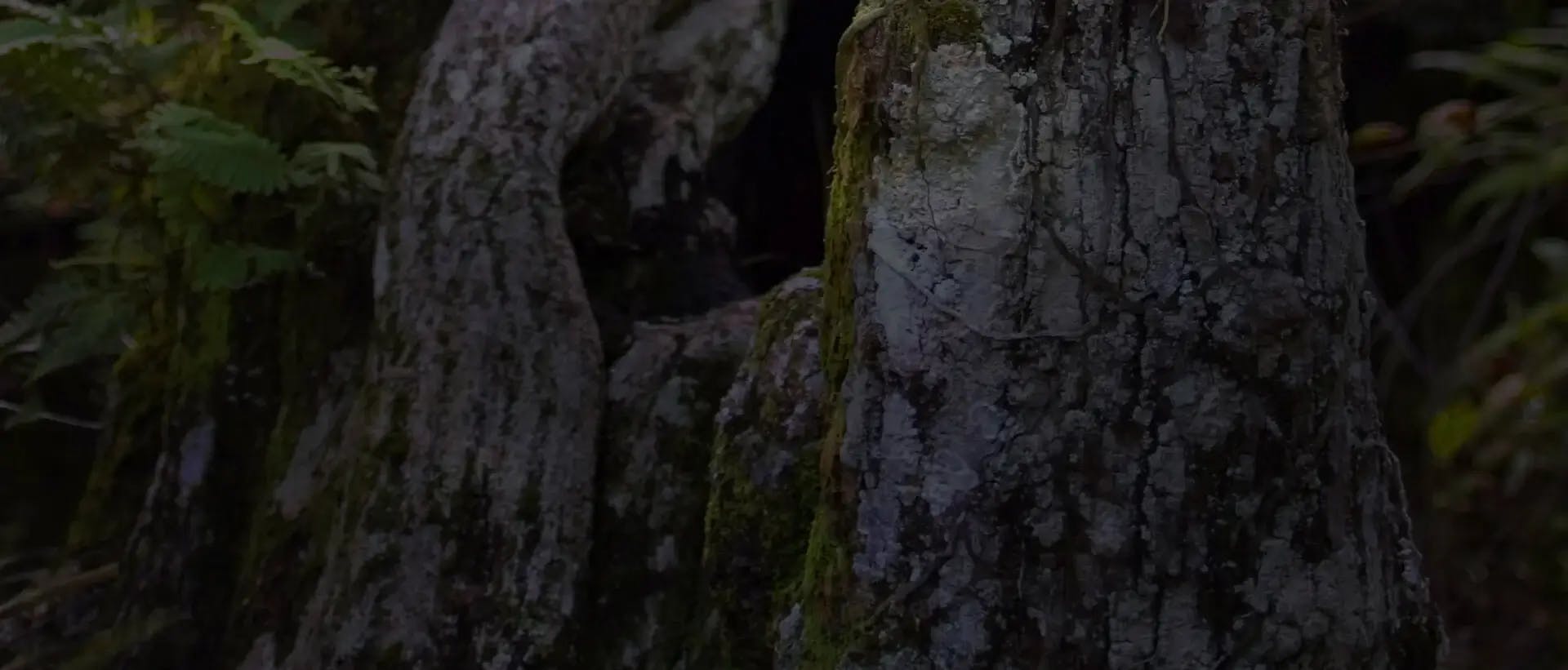
There are nine Anguloa species and four natural hybrids that are found in the north of South America, principally Colombia, Ecuador, Venezuela and Peru, where they grow at between 3,000 and 8,000 ft (1,000–2,500 m) in light shade or full sun, as terrestrials or lithophytes. They and their hybrids are very easy to grow if you have the space. One of my plants (Angulocaste Bievreana) first enjoyed the sunlight 120 years ago, the front keeps growing and the old pseudobulbs are cut off or die.
[1] Anguloa virginalis in sun at woodland’s edge in Peru. Photographed at about 7,500 feet (2,300 m). inset: Same species growing as a lithophyte in full sun at the same elevation.

In the United Kingdom (and the same would be true in other temperate parts of the world) a heated greenhouse is required, with a night temperature maintained at 54–60 F (12–15 C) and in the day at least 70 F (22 C) and below 85 F (30 C). I have a gas-fired central heating style boiler with finned greenhouse radiator pipes controlled by an air thermostat and a control box. The control box receives the temperature input from the thermostat and switches on the heating and ventilation when needed, with day and night set points. Cooling is provided by in-house fans, an exhaust fan and roof windows or vents. The roof vents are manually opened on one side and powered by a small electric motor on the other.
GROWING MEDIUM
Anguloas grow to be large plants with pseudobulbs commonly up to 10 inches (24 cm) tall and leaves to 50 inches (1.3m) long by 8 inches (20cm) wide so plenty of space is required. They are sympodial, so one or more new pseudobulbs are produced each year. At the beginning of the growing season, they should, if necessary, be repotted to provide sufficient space at the “front” of the plant for one more growth. They have hairy roots that need a water-retaining compost, so the roots do not dry out completely (if they do dry out completely the root hairs die and the function of the root is much impaired). Others may grow anguloas in chopped pine bark, but I have until recently, used 50 percent sphagnum moss with 50 percent perlite, the latter to improve drainage, but now use a type of rockwool called Grodan with 10–20 percent added horticultural perlite. This has the advantage of being weed-free, does not break down, and makes repotting much quicker. A disadvantage is that it is much heavier. Like all new composts, it takes a while to get used to it, so if you are more accustomed to bark, I would suggest adding 50 percent sphagnum to your mix.
[2] Anguloa root hairs. Allowing them to completely dry out destroys them and dramatically reduces the ability of the root to absorb moisture.

[3] Anguloa brevilabris with giant pseudobulbs. the plant was part of a display at the 2011 Medellín, Colombia show.

[4] This normal Anguloa pseudobulb measured 9 inches (23 cm).

[5] New growths and flower buds appear together in the spring.

HUMIDITY
High humidity does not seem to be a pressing requirement. I like watering the heating pipes when they are hot and drying the air, it makes the greenhouse feel more tropical, but in the summer British air is humid enough and, as the temperature falls in the evening, the humidity naturally rises — as it does in the Andes. In the past, when I used mist jets all the time, the humidity during the day was so high that clouds formed in the upper half of the greenhouse at night.
That was before water meters and paying for the amount one used and is much more than necessary. However, if you live in an arid zone you need to augment your greenhouse humidity during the day — it also helps to cool the air.
[6] Anguloa flower stems with sweet pea rings to train the flowers.

[7] Anguloa cliftonii flowers staked and tied with horticultural twine.

GROWING AND FLOWERING SEASON
The annual growth cycle begins around February. At that time we have no shading on the greenhouse, so the plants have maximum light. Sometimes the leaves will have dropped off at this time, and the plant is merely pseudobulbs, so — like a cactus — is not transpiring water and should be watered only if the bulbs begin to shrivel. Even if the leaves are still present, the plant is not growing so treat it as semidormant and restrict watering. When the new growth and the flower buds appear together at the base of the front of the lead bulb, gradually start to water normally again. At this time new roots are forming and will continue to grow below the surface through the summer as the vegetation grows above it.
The new growth and the flowers grow vertically, together, side by side. If the plant is for exhibiting, the buds should be trained to face outwards by pulling the lengthening stalks forward and tying them to stakes. Angling the inflorescences away from the old bulbs orients the flower buds facing away as well — so they can be better admired by the judges. If you do not do this, most anguloas will have their flowers randomly arranged with some facing forward, some backward and others sideways —reducing their visual impact. The inflorescences will need to be retied every week (or more frequently as they elongate) to separate the enlarging buds from each other, and although horticultural string can be used, the wire rings used for sweet peas are quicker.
Old leaves may be huge with a spread of up to 6 feet (1.8 m) and may persist to flowering time. These obscure the flowers so, if the plant is for exhibition, cut them off with sterilized scissors. The kitchen spray that kills all viruses including COVID should work if you leave the scissors in it for 5 minutes, otherwise use domestic bleach which should be instantaneous.
Flowering time varies from species to species, and the season usually starts with Anguloa uniflora and its primary hybrids at the beginning of May and continues through to July with Anguloa brevilabris usually last — hybrids can follow the flowering times of one or another of its parents, so are less consistent than the species. The peak time is mid-June to mid-July in my greenhouse.
[8] Anguloa uniflora with flowers well arranged.

[9] This plant is 6 feet (1.8 m) across!

[10] Anguloas can get to be large plants.

EXHIBITING
One of the pleasures of growing orchids is exhibiting them and anguloas are useful as they have fresh leaves (with none of the marks that can accumulate later in the year) at the same time as their large flowers. The flowers bruise when transporting them if they rub together, so before loading them up, take all the canes out that you have used to position the flowers, put them all back again and re-tie the flower scapes so that none of the flowers are touching. On arrival at the showground, before putting the plant in its place, untie and remove the canes and the flowers should return to their previously designated positions.
The Orchid Society of Great Britain Show team sets up my major exhibits: transporting them, mossing, labeling and all the extras, ready for the judges and the visitors. The latter are another of the pleasures of exhibiting anguloas — the visitors get to sniff the flowers and guess the fragrance, and we explain the mysteries of the intoxicated bees that pollinate them.
As flowering finishes, deadhead the old flowers by snapping them off with your fingers (scissors transmit viruses). Leaf growth continues and as they begin to spread out, reposition the plants so the leaves of one do not overshadow those of another. They need lots of space.
[11] Photographed in December, this leaf is 7.9 inches wide and 51 inches long (20 cm × 130 cm).

WATER AND NUTRITION
All the time that the plants are growing, treat them like teenagers — feed them. Water regularly, let them dry out between watering only to the “dampness” stage, and water heavily with each watering. With Grodan, which is inert, the only nutrition the plants will receive is from chemical fertilizers added to the water so use a high nitrogen feed throughout this time. I use Peters Excel, and as I use hard London tap water, this is Peters Excel Hard Water Grow Special 18–10–18 (+2MgO+TE) (Nitrogen-Potassium- Phosphorus+Magnesium Oxide+trace elements) which contains a buffer to neutralize the calcium carbonate of tap water. The Thames Water company says the calcium carbonate content of the water supplied to me is 400 parts per million (ppm) but my TDS meter says it is 600 ppm, so I add Peters to increase the solute content of the water to between 1,000–1,200ppm. If one only uses a small amount of water + fertilizer, one does not flush out the build-up of fertilizer or the calcium in hard water and toxic levels accumulate and leaf dieback occurs. For this reason, use plenty of water each time you water. Every few waterings, I water only with tap (or rain) water and no fertilizer to ensure that excess fertilizer is flushed out.
Whatever fertilizer you are used to, if you follow the idea that the plant needs a higher proportion of nitrogen when growing and more phosphorus when preparing to flower you will be correct. Whatever you do, whether you are watering from large water tanks via an electric pump and a hose (that is me), or watering phalaenopsis on a windowsill under the kitchen tap, if you are using hard water or adding fertilizer, always give enough to flush out residual chemicals. If you have rainwater, you do not need the fertilizer to be buffered.
Anguloas grow! If your plants have enough fertilizer, heat, and especially enough light, and you master the secret of watering enough but not too much, you will get specimen plants as the lead bulbs produce two new growths each year, and again the next year, but when they have eight lead growths one needs a crane to lift them.
By September the pseudobulbs are appearing, with the massive leaves from the top of the pseudobulb remaining, but the leaves that arise from the base of the pseudobulb start to drop off. This indicates that the bulb is maturing, and is not going to grow much more. I then change to Peter Excel Hard Water Finisher which is 14–10–26+2MgO+TE, i.e., high in phosphorus, the chemical which “hardens them off” and sets up flowering (and fruit production in tomatoes, etc). If you have clean rainwater, use the standard Peters Excel products without the hard water buffer \ both for the growing season and for hardening off.
[12] Anguloas awaiting staging at the RHS hampton court flower Show.

LIGHT AND AIR
The season starts when the new growth begins, with no shading and as much light as possible. In the wild, anguloas that grow in shade do not flower, those growing on woodland margins and on rocks in the open at 6,500 feet (2,000 m) in full sun do so. However, the plants in the open have continual mountain breezes at 60 F (15 C) or less to keep the leaves cool so they do not burn. In England, by the end of April, in the greenhouse, some sunny days are occurring, and light shading is needed and is certainly needed by the end of May. Feel the temperature of the leaves, if they are cool, they are transpiring (sweating) sufficient water to keep cool, if they are becoming hot, turn on internal fans to cool them down, or start applying the shading. “Coolglass” (a proprietary white greenhouse shading) sprayed on the outside, or green woven shade cloth are among the options. The control box switches on large internal fans and an exhaust fan and opens the roof vent when the temperature rises above 75 F (25 C). One of the fans is above bench level and one underneath, and if the outside temperature is 85 F (30 C) or above, I have mist jets under the benches (using tap water) to cool the air from the latter fan. I expect the humidity caused is also advantageous, but I have never measured it. If you put your anguloas outside in the sun in a British summer the leaves will burn on the first sunny day. Best avoided.
Keeping plants cool in the summer is as important as keeping them warm in the winter. “Good air movement,” the mantra of orchid growing manuals is more important for cooling plants than warding off fungal infestations. Anguloas need as much light as possible to grow and flower well, so better to be too warm than too shady. More fans are better than more shade.
In England, the shading can start coming off in September to increase the light exposure on the new leaves and induce flowering. Remember — too little light, too few flowers.
[13] A group of Anguloa Helen displayed at the RHS Hampton Court Flower Show with the Orchid Society of Great Britain, July of 2023 — RHS Holford medal.

RESTING
Not all the pseudobulbs will mature at once, but when a plant has finished growing, reduce or stop watering as noted earlier — and give as much light as possible. For three to four months (October-January) very little happens, they do not grow, and they do not flower, think of them as teenagers sleeping (they will awake eventually). Go on a vacation (if permitted).
[14] The Anguloa exhibit at the RHS Hampton Court Flower Show in June-July of 2024 — Eric Young Trophy.

[15] Anguloas at Hampton court - RHS Holford Medal with Orchid Society of Great Britain.

REPOTTING
I like to repot between December and February when the plants are resting (dormant) and about to start growth. If there is space for another year’s growth and the plants looks healthy, leave them alone. However, if there are five or more backbulbs, tip the plant upside down, remove the pot, separate a pair of pseudobulbs from the back of the plant (use clean pruners, etc.) and pot them up. The main part of the plant can then be “potted on” — not removing old compost and disturbing the roots as little as possible — by putting the oldest pseudobulb against the edge of the pot, adding fresh compost (Grodan + perlite) in front of the leading pseudobulb(s) and into any spaces round the side. Pot lightly, and do not compress the compost. Plants in which the lead bulbs are touching the sides need to be repotted, and if they do not need dividing or removing backbulbs, just “pot on” into a larger pot — again leaving the roots undisturbed and putting fresh compost into the space. Use plastic pots, they are lighter, and there is nothing wrong with them.
One can repot at any time if the plant is outgrowing its pot, but only “potting-on” as above, without disturbing the roots.
[16] The author explaining Anguloas at the Hampton Court Flower Show. Photograph copyright by Paul Upward.

PROPAGATING
Backbulbs potted up separately usually sprout within a few months if kept under the bench or other shady place and kept moist. If they sprout from the top of the bulb, repot so the pseudobulb is deep in the compost so the new roots from the “keiki” enter the compost. They take about three years to reach flowering size.
[17] Anguloas in the greenhouse in August as the leaves begin to spread out.

DISEASES
The management of pests is much the same as with other orchids. The new growths can rot if water and insecticide lodge in them, so it is best not to spray them unless necessary, but older leaves should be sprayed at the first sign of infestation to stop it from spreading. The Royal Horticultural Society in the United Kingdom recommends systemic insecticides such as Acetamprid, but each country will have different regulations about what is allowed. There is nothing you can do about viruses, which are common, but cytomegalovirus may not affect the flowers whereas odontoglossum ring spot virus usually does. It is a personal choice if you throw away infected plants or just soldier on and not use them for exhibitions (or give away pieces to other growers). Occasionally virused plants appear to "grow out of it” and become symptom-free (no streaky leaves), so I am a “keeper” rather than a “thrower outer.”

— Henry Oakeley is the author of Lycaste, Ida and Anguloa. The Essential Guide. Now nearly out of print, a few copies are still Dr. Henry Francis Oakeley available from the author (website www.oakeleybooks.com; email henry.oakeley@virgin.net).
[18] This pseudobulb still has both side leaves.

[19] Pseudobulb having lost one side leaf.

[20] Maturing pseudobulb with no side leaves.

[21] Leaf scorch on an anguloa put out in July sunshine in England.

[22] Kept too dry as the leaves rapidly expand causes this crinkling.

[23] The natural hybrid Anguloa ×speciosa.

[24] Repotting a dormant Anguloa in December.

[25] Repotting an actively growing Anguloa in May.

[26] The two small backbulbs on this plant can be removed during repotting.

[27] Sprouting backbulb in Grodan and Perlite.

[28] Keiki growing from the top of the backbulb.

[29] Anguloa Isabelle.













